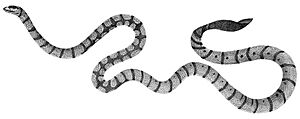Yellow sea snake facts for kids
Quick facts for kids Yellow sea snake |
|
|---|---|
 |
|
| Conservation status | |
| Scientific classification | |
| Genus: |
Hydrophis
|
| Species: |
spiralis
|
| Synonyms | |
The Hydrophis spiralis, often called the yellow sea snake, is a type of venomous snake that lives in the ocean. It belongs to a group of sea snakes and is part of the Elapidae family. These snakes are known for their bright yellow color and their long bodies.
About the Yellow Sea Snake
This snake is one of the longest sea snakes in the world! It can grow up to 3.0 metres (9.8 ft) long, which is about the length of a small car. However, most of them are usually around 2.0 meters long. This ocean snake is active both during the day and at night. This means you might see it swimming around at any time!
What Does It Look Like?
The scales on the thickest part of its body are rounded or pointed. They overlap each other, like roof tiles. This snake has a few small teeth behind its main fangs.
Around its neck, it has about 25 to 31 rows of scales. Around the middle of its body, it has 33 to 38 rows. The scales on its belly are very clear and about twice as wide as the scales next to them. There are between 295 and 362 of these belly scales.
Its color is usually yellowish or yellowish-green on top. The edges of its back scales are black. It has 41 to 46 thin black bands that go all the way around its body. These bands are usually much narrower than the lighter yellow spaces between them.
When the snake is young, its head is black with a yellow mark shaped like a horseshoe. As it gets older, its head usually turns yellow. Male yellow sea snakes are about 1.62 metres (5.3 ft) long, and females are a bit longer, around 1.83 metres (6.0 ft). Their tails are shorter, about 140 millimetres (5.5 in) for males and 120 millimetres (4.7 in) for females.
Where Do Yellow Sea Snakes Live?
The Hydrophis spiralis lives in the Indian Ocean. You can find it off the coasts of many countries, including Oman, United Arab Emirates, Iran, Iraq, Saudi Arabia, Bahrain, and Kuwait.
It also lives near Pakistan, Sri Lanka, India (including the Andaman & Nicobar Islands), Indonesia, Bangladesh, Malaysia, Philippines, China, New Guinea, New Caledonia/Loyalty Islands, Thailand, Vietnam, Brunei, Cambodia, and Myanmar. These snakes can live in water as deep as 50 meters (about 164 feet)!


